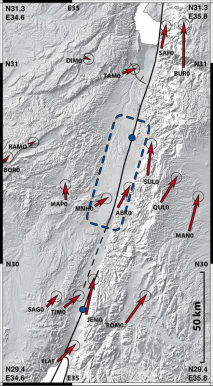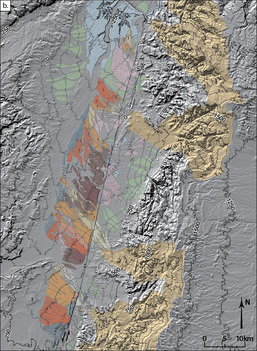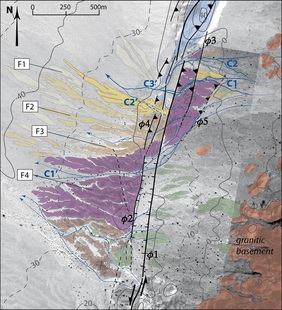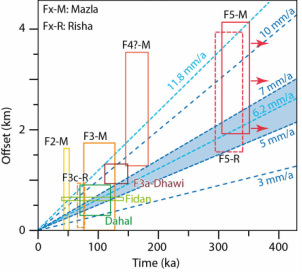Strike-slip fault kinematics > Geodetic versus Quaternary fault slip rate along the southern Dead Sea fault
|
Motivation and approach
Focusing on a fault segment with a simple linear geometry, isolated from other major active structures, we aimed at investigating the following questions regarding the kinematic behavior of active faults:
- Is fault slip rate constant or variable through time? Variable fault slip rate would imply temporal variations in the earthquake cycle (variable earthquake recurrence or magnitude). - How does interseismic present-day slip rate compare with long-term slip rate? To answer these questions, we combined geodesy (GPS) and geomorphic measurements of offset alluvial surfaces that we dated using 10Be cosmogenic isotope. Complementary dating using luminescence techniques are on-going. Read more: Tectonic setting of the Dead Sea fault |
GPS: present-day fault slip rate and locking depth
|
Late Quaternary 10-ka to 300-ka slip rates
|
The Wadi Araba fault runs along a valley blanketed in Quaternary sediments that archived tectonic displacements along the fault and climatic variations impact on alluvial systems. We used a series of offset alluvial fans dated from 10 ka to about 300 ka to propose Late Quaternary fault slip rates on the Wadi Araba fault.
Read more:
Le Béon et al, 2010, J. Geophys. Res., 115, B11414, doi:10.1029/2009JB007198 Le Béon et al, 2012, Tectonics, 31, TC5003, doi:10.1029/2012TC00311 |
|
|
Conclusion : fault slip rate over time?
Numerous studies have investigated fault slip rate along the southern Dead Sea fault, at time scales from a few years to several million years. They agree fairly well on an average slip rate of 5.0 ± 0.9 mm/a. Those results at different time scales may be compared to infer the seismic behavior of the Wadi Araba fault segment. Available data could all be fitted by a straight line, meaning a constant fault slip rate of 5-7 mm/a over time. Then, Wadi Araba fault would produce large earthquakes quasi-periodically, at least over our shorter observation time window, about 12 ka, shown to be long enough to average any possible irregularity. However, due to large uncertainties that affect Late Pleistocene rates, temporal variations in fault slip rate cannot be excluded. OSL dating of a key marker for which offset is well constrained is in progress in order to better determine age and slip rate. We also recently started paleosismic investigations to observe the earthquake sequence during a shorter time period, up to the Early to Middle Holocene. |
Synthesis of Late Quaternary data
with comparison to GPS and geological slip rates |




